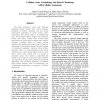47 search results - page 3 / 10 » Changing the Neighborhood of Cellular Automata |
ICTAI
2005
IEEE
14 years 1 months ago
2005
IEEE
This paper proposes a novel data clustering algorithm, coined ‘cellular ants’, which combines principles of cellular automata and ant colony optimization algorithms to group s...
TCS
2011
13 years 2 months ago
2011
This paper presents a 1D intrinsically universal cellular automaton with four states for a first neighbors neighborhood, improving on the previous lower bound and getting nearer ...
SIAMCOMP
2002
13 years 7 months ago
2002
Linear quantum cellular automata were introduced recently as one of the models of quantum computing. A basic postulate of quantum mechanics imposes a strong constraint on any quan...
CORR
2010
Springer
13 years 4 months ago
2010
Springer
In a probabilistic cellular automaton (PCA), the cells are updated synchronously and independently, according to a distribution depending on a finite neighborhood. A PCA can be vi...
JAC
2008
13 years 9 months ago
2008
Cellular automata are a simple model of parallel computation. Many people wonder about the computing power of such a model. Following an idea of S. Wolfram [16], M. Cook [3] has pr...

